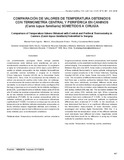Comparación de valores de temperatura obtenidos con termometría central y periférica en caninos (Canis lupus familiaris) sometidos a cirugía
Fecha
2019Palabras Clave
Temperatura, Monitorización, Caninos, AnestesiaTemperature, Monitoring, Canine, Anesthesia
Metadatos
Mostrar el registro completo del ítemResumen
Los procedimientos quirúrgicos llevan consigo posibles complicaciones, tanto médicas como anestésicas, por esto la monitorización anestésica es de vital importancia. Un parámetro a vigilar es la temperatura corporal. Entre mayo y junio 2015 se realizó un estudio comparativo de tres métodos termométricos en pacientes caninos sometidos a cirugías en el Hospital Clínico Veterinario Docente (HCVD) de la Universidad Santo Tomás (UST), Talca, Chile. Al correlacionar los tres métodos, se obtuvo una asociación positiva entre todos ellos, sin embargo, al correlacionarlos de manera individual se obtuvieron diferentes resultados: la correlación entre el método rectal y esofágico (RE) fue baja, al igual que en la correlación de los métodos esofágico y axilar (EA). La correlación entre el método rectal y axilar (RA) fue alta. Al realizar las pruebas comparativas individuales, los valores de los tres métodos termométricos no evidenciaron diferencias significativas (P≥ 0,05). En las pruebas comparativas entre los métodos centrales y periféricos no se evidenciaron diferencias significativas (P ≥ 0,05). Con esto se concluye que los valores de temperatura de los distintos métodos empleados comparados en forma individual poseen magnitudes distintas pero similares, lo que se traduce en que no habría diferencia en usar cualquiera de estos métodos para la monitorización anestésica
Colecciones
Información Adicional
| Otros Títulos | Comparison of Temperature Values Obtained with Central and Periferal Thermometry in Canines (Canis lupus familiaris) Submitted to Surgery |
| Correo Electrónico | marisolagurtome@santotomas.cl |
| Editor | SaberULA |
| ISSN | 0798-2259 |
| ISSN Electrónico | 2477-944X |
| Resumen en otro Idioma | Surgical procedures include intrinsic complications, both medical and anesthetic, so the anesthetic monitoring is vital to maintain the patient integrity. One parameter to watch is the body temperature. Between May and June 2015, it was made a comparative study of three methods thermometric in canine patients undergoing to various surgical procedures in the Clinical Veterinary Teaching Hospital (HCVD) of the Santo Tomás University (UST), Talca, Chile. The correlation of different thermometric methods showed that there was a positive partnership between them, however, when they were individually correlated, different results were obtained: the correlation between esophageal and rectal method (RE) was low, also the correlation value between the esophageal and axillary method (EA) was low. The correlation between the rectal and axillary (RA) methods was high. When comparing individual values thermometric methods, no significant differences between them were evidenced (P ≥ 0.05). In the comparative proof between central and peripherals methods no significant differences were evidenced (P ≥ 0.05). In the benchmark, it was determined that there is no significant difference between the thermometric measurements of rectal thermistor probe, esophageal and axillary digital thermometer. With this, it is concluded that the temperature values of the different methods used individually have different but similar magnitudes, which means that there would be no difference in using any of these methods for anesthetic monitoring |
| Colación | 407-413 |
| País | Venezuela |
| Institución | Universidad del Zulia (LUZ) Universidad de Los Andes (ULA) |
| Publicación Electrónica | Revista Científica |






